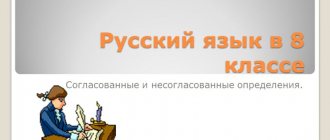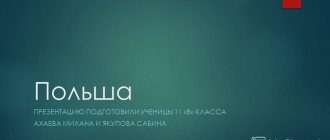Topic: Generalization and systematization of knowledge about hydrocarbons
Author:
.
Full name of educational institution:
Regional state budgetary professional educational institution "Altai College of Architecture and Civil Engineering" Barnaul, Altai Territory.
Item:
Chemistry.
Subject:
Generalization and systematization of knowledge about hydrocarbons.
Class:
I year (10th grade).
Educational and methodological support:
Gabrielyan. Grade 11. A basic level of. – M.: Bustard, 2011. Cards with crosswords.
Lesson time:
45 minutes
The purpose of the lesson:
Review the topics in the “Hydrocarbons” section, summarize and systematize students’ knowledge in this section, and prepare for the test.
Lesson objectives:
Educational:
generalize and systematize students’ knowledge about hydrocarbons and their derivatives based on comparative characteristics of their properties.
Educational:
develop logical thinking based on the chemistry of hydrocarbons and their derivatives; develop students’ chemical speech, the ability to answer questions reasonably, and develop students’ communication abilities.
Educational:
During the lesson, promote the formation of students’ scientific worldview, understanding the essence of the process
, and
cultivate the ability to listen to the answers of classmates.
Lesson type:
a lesson in systematizing and summarizing what has been learned.
Lesson format:
lesson-quiz
.
Equipment:
multimedia projector, computer, screen.
Lesson plan:
| Lesson steps | Temporary implementation |
| 1. Organizational moment | 3 min. |
| 2. Setting the goals and objectives of the training session | 2 minutes. |
| 3. Generalization and systematization of knowledge | 33 min. |
| 4. Summing up the lesson | 7 min. |
During the classes:
1. Organizing time
: greeting students, recording absentees.
2. Setting the goals and objectives of the training session
: with the help of the teacher’s leading questions, students draw conclusions that all topics within the “Hydrocarbons” section have been completed and in the current lesson they must repeat the material covered and prepare for the test, formulate the topic of the lesson and write it down.
3. Generalization and systematization of knowledge
: conducted in a playful manner in two stages - a quiz and a crossword puzzle. Students are divided into groups of 4 people.
Stage I – Quiz “Hydrocarbons” (presentation in MO Power Point – Appendix 1).
The quiz questions are divided into five groups:
1. Saturated hydrocarbons.
2. Unsaturated hydrocarbons.
3. Aromatic hydrocarbons.
4. Rubbers.
5. Natural sources of hydrocarbons.
Answers are awarded 5, 10 or 15 points, depending on the complexity of the question.
The results are entered into the evaluation sheet (Appendix 2).
The results of the first stage are summed up.
Stage II - Chemical crossword (Appendix 3).
The scientist's surname is encrypted in the highlighted cells of the crossword puzzle. Russian chemist, creator of the theory of chemical structure, head of the largest Kazan school of Russian organic chemists, public figure. For the first time he explained the phenomenon of isomerism. For the first time, based on the theory of chemical structure, he began a systematic study of polymerization, which was continued in Russia by his followers and culminated in the discovery of an industrial method for producing synthetic rubber. He was a champion of higher education for women, participated in the organization of the Higher Women's Courses in 1878, and created the chemical laboratories of these courses.
Teams solve crossword puzzles within 5 minutes. For each correctly written word, 5 points are awarded.
The results are entered into the score sheet.
4. Summing up the lesson:
counting the total points for two stages and announcing the results; congratulations to the winners; grading for the lesson; homework explanation.
List of sources:
1. Borovsky tests in organic chemistry. Hydrocarbons. Grade 10. – M.: Publishing house “Exam”, 2013. – 157 p.
2. Gabrielyan chemistry in tests, tasks, exercises. Grade 10. – M.: Bustard, 2003. – 400 p.
3., Ostroumov's book by a chemistry teacher. Grade 10. – M.: Blik and Co., 2001.
Appendix 2
Evaluation paper
| No. | Team composition | Fixing Stage I points | Result of stage I | Result of stage II | Grand total |
| 1 | |||||
| 2 | |||||
| 3 | |||||
| 4 | |||||
| 5 | |||||
| 6 |
Appendix 3
III
: Chemical crossword
| 1 |
| 2 |
| 3 |
| 4 |
| 5 |
| 6 |
| 7 |
| 8 |
1. The fourth substance in the homologous series of methane.
2. A chemical element found in all organic substances.
3. The simplest substance with a triple carbon-carbon bond, used for welding and cutting metals.
4. An aqueous solution of rubber from which balloons are made.
5. A substance that has the same composition, but a different structure.
6. The reaction of producing benzene from acetylene.
7. Saturated hydrocarbon, the isomer of which is an indicator of the quality of gasoline.
8. Scientist who discovered a method for the synthesis of saturated hydrocarbons by the action of metallic sodium on haloalkanes.
Standard answers
| B | U | T | A | N | |||||||
| U | G | L | E | R | ABOUT | D | |||||
| A | C | E | T | AND | L | E | N | ||||
| L | A | T | E | TO | WITH | ||||||
| AND | Z | ABOUT | M | E | R | ||||||
| T | R | AND | M | E | R | AND | Z | A | C | AND | I |
| ABOUT | TO | T | A | N | |||||||
| IN | YU | R | C |




